GMC YUKON XL DENALI 2001 Owners Manual
Manufacturer: GMC, Model Year: 2001, Model line: YUKON XL DENALI, Model: GMC YUKON XL DENALI 2001Pages: 394, PDF Size: 2.77 MB
Page 281 of 394
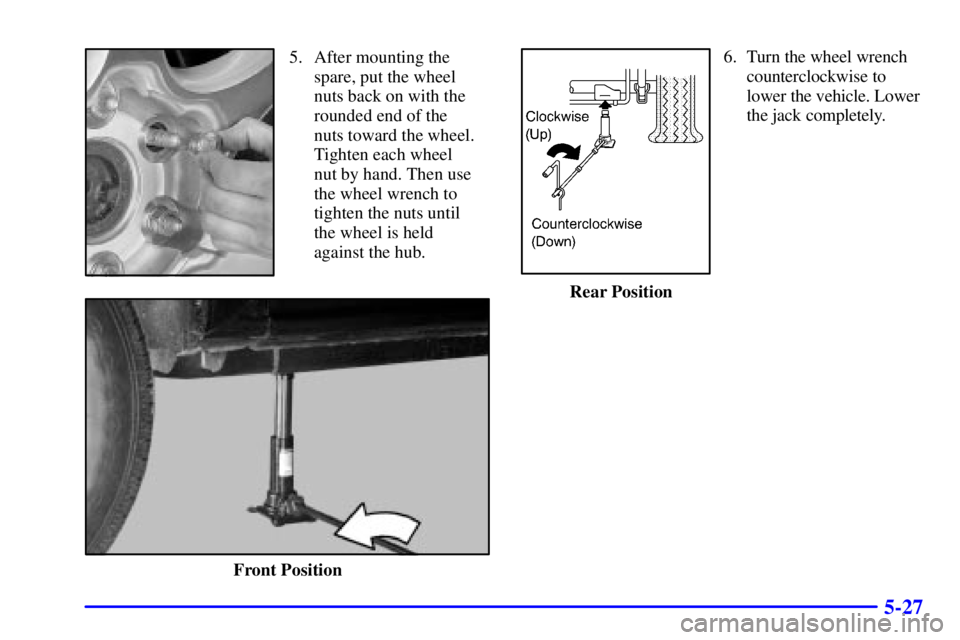
5-27
5. After mounting the
spare, put the wheel
nuts back on with the
rounded end of the
nuts toward the wheel.
Tighten each wheel
nut by hand. Then use
the wheel wrench to
tighten the nuts until
the wheel is held
against the hub.
Front Position
6. Turn the wheel wrench
counterclockwise to
lower the vehicle. Lower
the jack completely.
Rear Position
Page 282 of 394
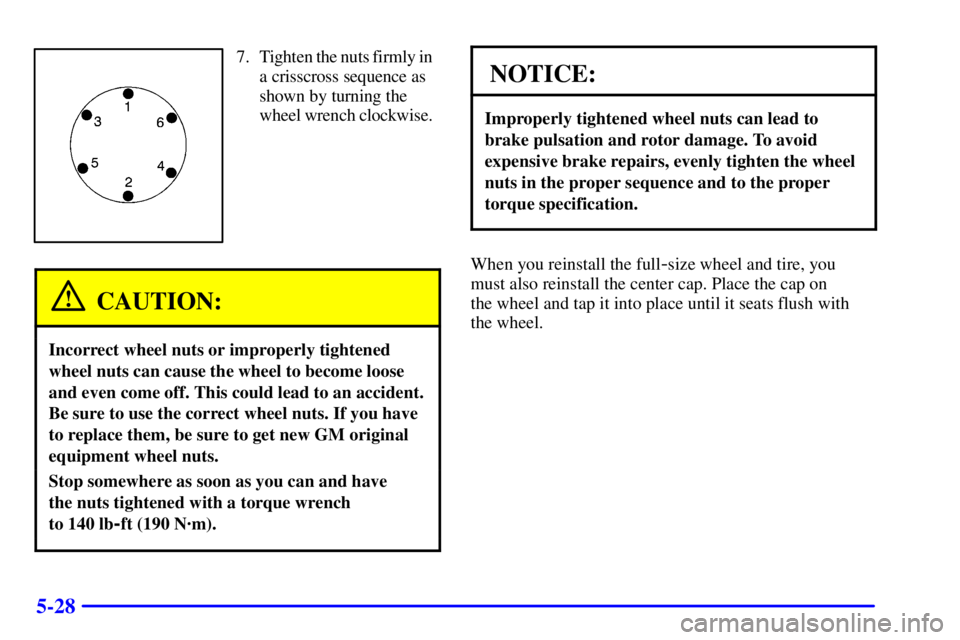
5-28
7. Tighten the nuts firmly in
a crisscross sequence as
shown by turning the
wheel wrench clockwise.
CAUTION:
Incorrect wheel nuts or improperly tightened
wheel nuts can cause the wheel to become loose
and even come off. This could lead to an accident.
Be sure to use the correct wheel nuts. If you have
to replace them, be sure to get new GM original
equipment wheel nuts.
Stop somewhere as soon as you can and have
the nuts tightened with a torque wrench
to 140 lb
-ft (190 N´m).
NOTICE:
Improperly tightened wheel nuts can lead to
brake pulsation and rotor damage. To avoid
expensive brake repairs, evenly tighten the wheel
nuts in the proper sequence and to the proper
torque specification.
When you reinstall the full-size wheel and tire, you
must also reinstall the center cap. Place the cap on
the wheel and tap it into place until it seats flush with
the wheel.
Page 283 of 394
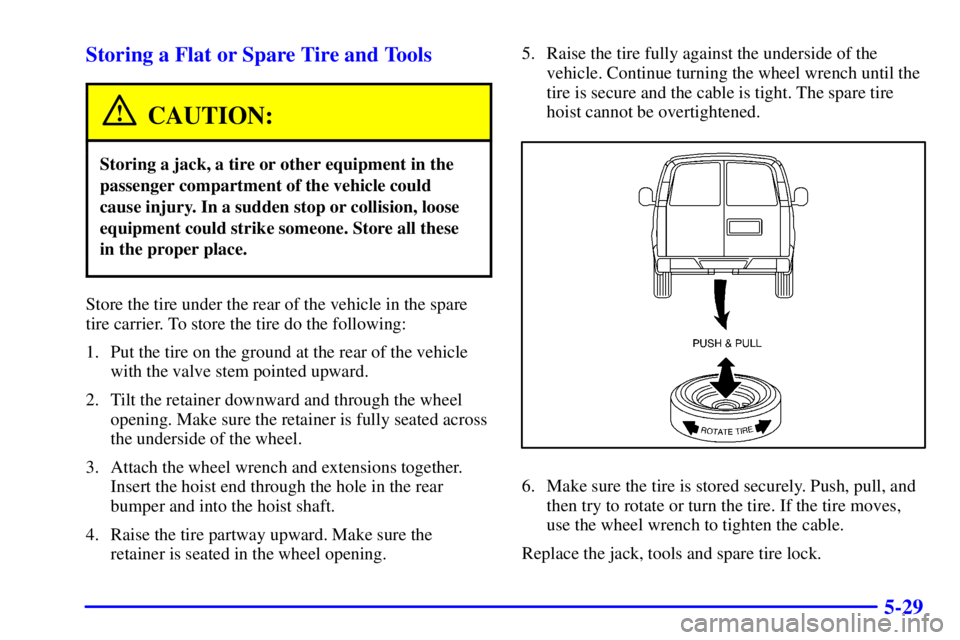
5-29 Storing a Flat or Spare Tire and Tools
CAUTION:
Storing a jack, a tire or other equipment in the
passenger compartment of the vehicle could
cause injury. In a sudden stop or collision, loose
equipment could strike someone. Store all these
in the proper place.
Store the tire under the rear of the vehicle in the spare
tire carrier. To store the tire do the following:
1. Put the tire on the ground at the rear of the vehicle
with the valve stem pointed upward.
2. Tilt the retainer downward and through the wheel
opening. Make sure the retainer is fully seated across
the underside of the wheel.
3. Attach the wheel wrench and extensions together.
Insert the hoist end through the hole in the rear
bumper and into the hoist shaft.
4. Raise the tire partway upward. Make sure the
retainer is seated in the wheel opening.5. Raise the tire fully against the underside of the
vehicle. Continue turning the wheel wrench until the
tire is secure and the cable is tight. The spare tire
hoist cannot be overtightened.
6. Make sure the tire is stored securely. Push, pull, and
then try to rotate or turn the tire. If the tire moves,
use the wheel wrench to tighten the cable.
Replace the jack, tools and spare tire lock.
Page 284 of 394

5-30
A. Hoist Assembly
B. Wheel Wrench
C. Jack
Handle Extensions
D. Hoist ShaftE. Valve Stem,
Pointed Up
F. Flat or Spare Tire
G. Tire Retainer
H. Hoist Cable
To store the tools, follow these procedures:For Denali Models:
Denali Models (Under Driver's Side Rear Seat)
A. Tool Kit with Jack Tools and Gloves
B. Bracket and Wing Nut
Page 285 of 394

5-31
Denali Models (Rear Access Panel)
A. Speaker
B. Bottle Jack
C. Wing Nut
D. Retaining Hook
E. Tire Blocks
F. Cover Panel1. Put the tool kit, with the jack tools and gloves, in the
tool bag and place in the retaining bracket under the
second row passenger's seat on the driver's side of
the vehicle.
2. Tighten down with the wing nut.
3. Then, assemble tire blocks (E) and bottle jack (B)
together with the wing nut and retaining hook (D).
4. Position behind the jack storage cover in the rear
side panel on the driver's side of the vehicle just
below the speaker (A) and tighten, adjusting
clockwise until the jack is secured tight in the
mounting bracket.
Page 286 of 394
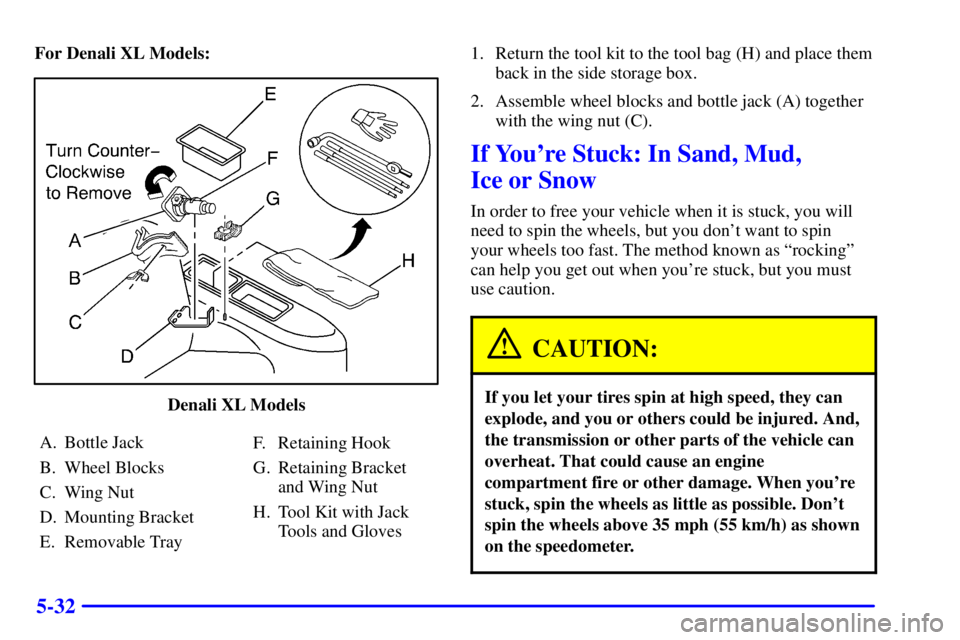
5-32
For Denali XL Models:
Denali XL Models
A. Bottle Jack
B. Wheel Blocks
C. Wing Nut
D. Mounting Bracket
E. Removable TrayF. Retaining Hook
G. Retaining Bracket
and Wing Nut
H. Tool Kit with Jack
Tools and Gloves1. Return the tool kit to the tool bag (H) and place them
back in the side storage box.
2. Assemble wheel blocks and bottle jack (A) together
with the wing nut (C).
If You're Stuck: In Sand, Mud,
Ice or Snow
In order to free your vehicle when it is stuck, you will
need to spin the wheels, but you don't want to spin
your wheels too fast. The method known as ªrockingº
can help you get out when you're stuck, but you must
use caution.
CAUTION:
If you let your tires spin at high speed, they can
explode, and you or others could be injured. And,
the transmission or other parts of the vehicle can
overheat. That could cause an engine
compartment fire or other damage. When you're
stuck, spin the wheels as little as possible. Don't
spin the wheels above 35 mph (55 km/h) as shown
on the speedometer.
Page 287 of 394
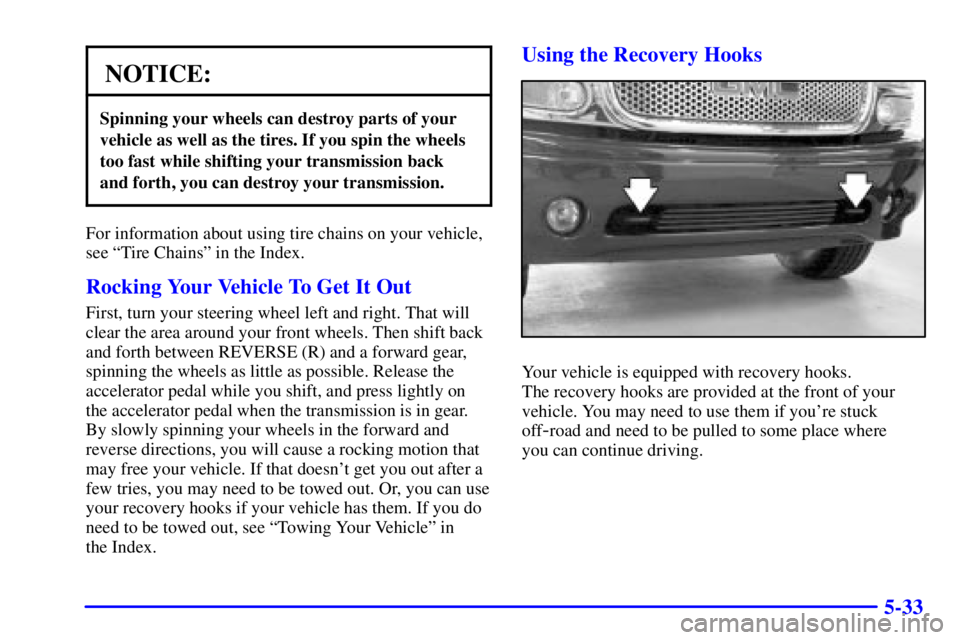
5-33
NOTICE:
Spinning your wheels can destroy parts of your
vehicle as well as the tires. If you spin the wheels
too fast while shifting your transmission back
and forth, you can destroy your transmission.
For information about using tire chains on your vehicle,
see ªTire Chainsº in the Index.
Rocking Your Vehicle To Get It Out
First, turn your steering wheel left and right. That will
clear the area around your front wheels. Then shift back
and forth between REVERSE (R) and a forward gear,
spinning the wheels as little as possible. Release the
accelerator pedal while you shift, and press lightly on
the accelerator pedal when the transmission is in gear.
By slowly spinning your wheels in the forward and
reverse directions, you will cause a rocking motion that
may free your vehicle. If that doesn't get you out after a
few tries, you may need to be towed out. Or, you can use
your recovery hooks if your vehicle has them. If you do
need to be towed out, see ªTowing Your Vehicleº in
the Index.
Using the Recovery Hooks
Your vehicle is equipped with recovery hooks.
The recovery hooks are provided at the front of your
vehicle. You may need to use them if you're stuck
off
-road and need to be pulled to some place where
you can continue driving.
Page 288 of 394
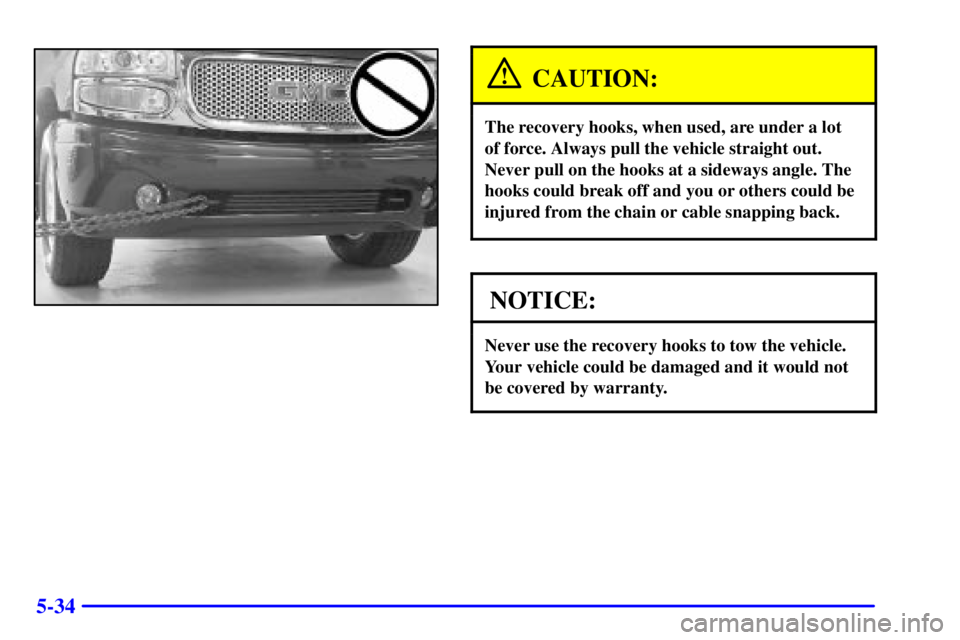
5-34
CAUTION:
The recovery hooks, when used, are under a lot
of force. Always pull the vehicle straight out.
Never pull on the hooks at a sideways angle. The
hooks could break off and you or others could be
injured from the chain or cable snapping back.
NOTICE:
Never use the recovery hooks to tow the vehicle.
Your vehicle could be damaged and it would not
be covered by warranty.
Page 289 of 394

6-
6-1
Section 6 Service and Appearance Care
Here you will find information about the care of your vehicle. This section begins with service and fuel information,
and then it shows how to check important fluid and lubricant levels. There is also technical information about your
vehicle, and a part devoted to its appearance care.
6
-2 Service
6
-3 Fuel
6
-5 Fuels in Foreign Countries
6
-5 Filling Your Tank
6
-7 Filling a Portable Fuel Container
6
-8 Checking Things Under the Hood
6
-10 Engine Oil
6
-15 Engine Air Cleaner/Filter
6
-17 Passenger Compartment Air Filter
6
-17 Automatic Transmission Fluid
6
-21 Rear Axle
6
-21 All-Wheel Drive
6
-24 Engine Coolant
6
-27 Coolant Surge Tank Pressure Cap
6
-28 Power Steering Fluid6
-29 Windshield Washer Fluid
6
-30 Brakes
6
-34 Battery
6
-35 Bulb Replacement
6
-39 Windshield Wiper Blade Replacement
6
-40 Tires
6
-48 Appearance Care
6
-49 Cleaning the Inside of Your Vehicle
6
-52 Cleaning the Outside of Your Vehicle
6
-56 GM Vehicle Care/Appearance Materials
6
-57 Vehicle Identification Number (VIN)
6
-58 Electrical System
6
-66 Replacement Bulbs
6
-66 Capacities and Specifications
6
-67 Normal Maintenance Replacement Parts
Page 290 of 394
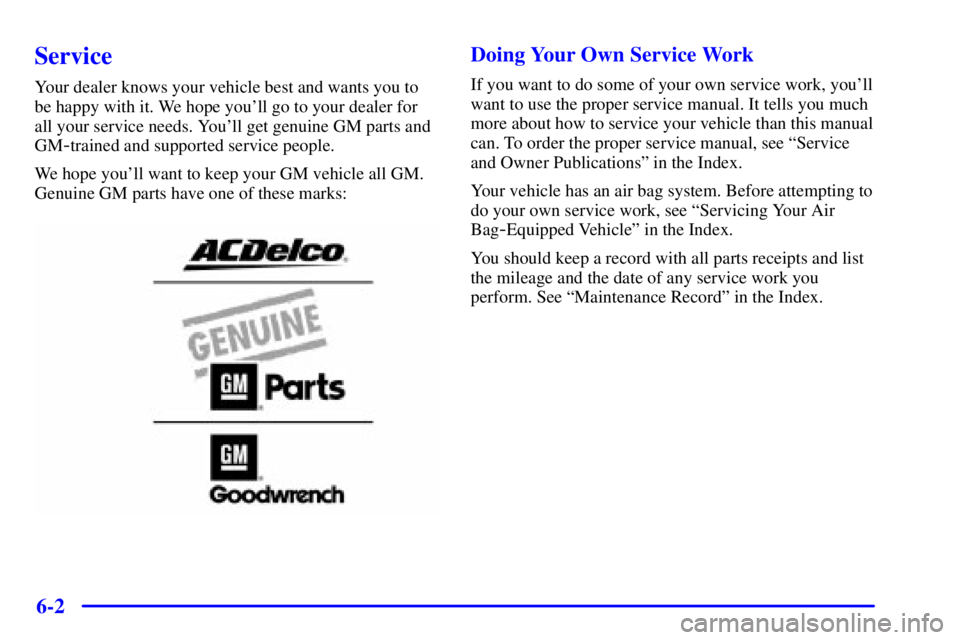
6-2
Service
Your dealer knows your vehicle best and wants you to
be happy with it. We hope you'll go to your dealer for
all your service needs. You'll get genuine GM parts and
GM
-trained and supported service people.
We hope you'll want to keep your GM vehicle all GM.
Genuine GM parts have one of these marks:
Doing Your Own Service Work
If you want to do some of your own service work, you'll
want to use the proper service manual. It tells you much
more about how to service your vehicle than this manual
can. To order the proper service manual, see ªService
and Owner Publicationsº in the Index.
Your vehicle has an air bag system. Before attempting to
do your own service work, see ªServicing Your Air
Bag
-Equipped Vehicleº in the Index.
You should keep a record with all parts receipts and list
the mileage and the date of any service work you
perform. See ªMaintenance Recordº in the Index.